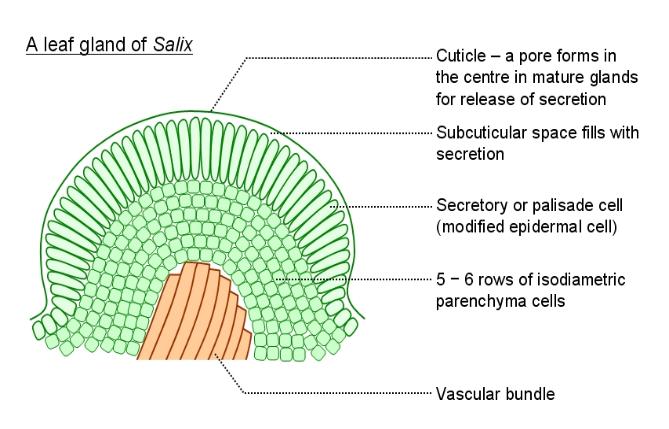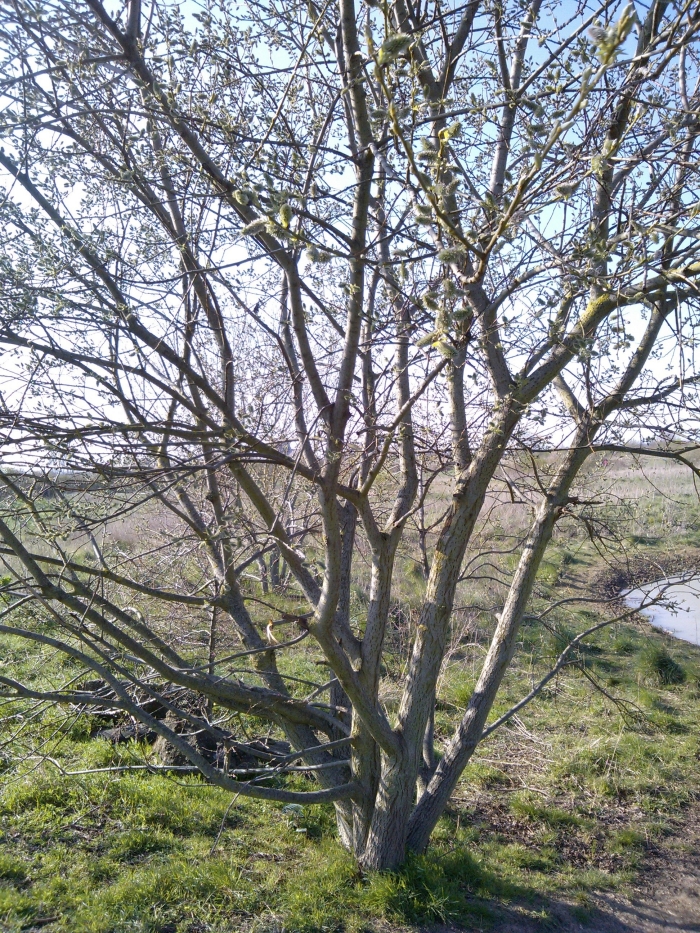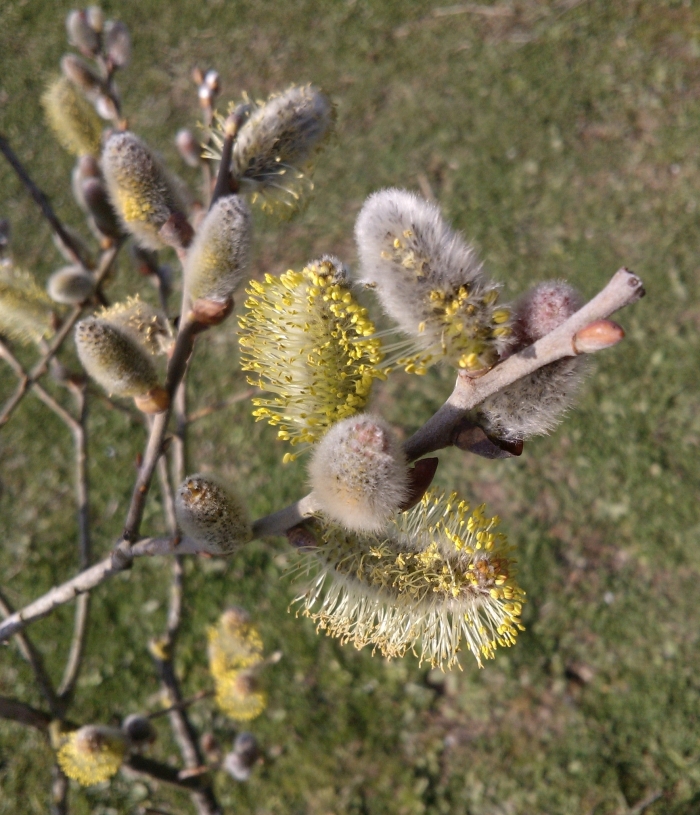
A 3D computer model of a Crack Willow (Salix fragilis) growing on the bank of a river. The Crack Willow is a largish tree typically 10-20 meters tall but sometimes 25-30 meters tall with spreading branches growing at angles of 60 to 90 degrees and prefers wet soils with its roots able to grow well in water. The Crack Willow is so-called because of its tendency to fragment and drop twigs and branches into the water. The twigs of willows in general will root if planted and produce new trees and the branches and twigs of willow may lodge downstream and root in the bank, forming new trees. This is a mode of asexual reproduction and dispersal that the crack willow is particularly good at. Indeed, sometimes whole trunks split apart. To prevent such dropping of branches, willows are often pollarded, though pollarding of trees can itself cause mechanical failure of tree trunks. In pollarding the tree is cut back to about 2 meters above ground and it responds by producing more smaller branches, an adaptive response to browsing and wind-damage, however, if these branches are left to grow too large the crown may become top-heavy and overload the trunk which may split, as has happened in some old oak pollards, but crack willow is especially prone to fragmentation as this assists its reproduction and colonisation of river banks.
The Crack Willow often has an irregular, leaning crown.
Willow Roots
Abobe:
a diagrammatic cross-section (transverse section, T.S.) through
a young submerged root of Salix
fragilis.
Willow's preference for water means that many of roots will be
growing in waterlogged soils or even directly into water. This
poses the problem of how to get oxygen in to the root cells.
Many plants respond to water-logging by developing air-spaces
within the root cortex (the cortex is the parenchyma tissue between the
epidermis and the vascular cylinder) which are continuous with
the normal air spaces in the shoots above ground. This allows
the aerial shoots to supply the roots with air. This spongy,
aerated parenchyma tissue is called aerenchyma. Being adapted for wet
conditions, willows like the crack willow excel in
(schizogenous). In either case the response is a coordinated
one. Cells in the root that lack (schizogenous). In either case
the response is a coordinated one. Cells in the root that lack
oxygen produce ethylene (a plant hormone or phytohormone) which,
in the lysogenous case, triggers the synthesis of cellulase, an
enzyme that degrades the cellulose cell walls of parenchyma
cells, resulting in their lysis.
Did you
know?
A willow root 114.5 feet in length was once found blocking a
storm sewer!
Bark
The
bark is green and smooth when young, becoming rough and grey
when older. The bark of willow trees the simplest type (also
found in Magnolia, apple, pear and poplar) and consists of an
opening filled with appearing later.)
The bark of willows contain high levels of the chemical salicylic acid (SA), a painkiller
which was extracted as a forerunner to aspirin. Aspirin has
fewer ill side-effects and can be easily made from salicylic
acid. Another related compound, found in the wintergreens, is
Oil of Wintergreen (methyl salicylate), also used as a
painkiller and antiseptic. SA is a plant hormone with multiple
functions, including activation of plant pathogen defense
systems by triggering production of antimicrobial
proteins. It can also trigger whole-plant protection in response
to a localised infection and by conversion to volatile methyl
salicylate it can pass this signal on to neighbouring plants and
so function as an alarm signal. SA possibly has some
antimicrobial properties of its own too, since it is an
effective treatment for warts, suggesting anti-viral properties
or some ability to prevent abnormal cell proliferation and
possibly protects the plant against tumour formation (as induced
by many pathogens). Aspirin has been shown to have anti-cancer
properties.
Despite the
fragility of the whole tree, the wood of Crack Willow hybrids is
used to make cricket bats. The wood is pale cream to pink-brown,
soft and brittle. Other willow species are famous for the
flexibility of their wood which makes them resistant to wind
damage, though these willows still have a tendency to shed many
living twigs which can root to produce new plants.
The wood of willow (Salix nigra) is (semi-)diffuse-porous
nonstoried wood with uniseriate heterocellular rays (!). Such
descriptions allow wood to be classified and the terms will now
be explained. Hardwoods are divided into two main types: ring-porous and diffuse-porous (though some types are
intermediate). In diffuse porous wood the early xylem vessels
(those formed in Spring) are no larger or only slightly larger
than those formed later in the year (though annual growth rings
are still visible) and is found in trees like maple, horse
chestnut and holly. Contrary to this is the ring-porous type of
wood in which the early xylem vessels are much larger than the
later vessels and form definite rings, forming rings of pores
visible with a hand-lens in a cross-section. Ring-porous trees
include most oak tree species.
There are three ways to section a trunk. A transverse section or
cross-section simply cuts across the long-axis, like removing a
slice or neat log. Lengthwise sections, slicing the trunk along
its height/axis may be of two types: radial sections cut through
the centre of the trunk, along a radius, cutting it into two
equal halves; tangential sections cut a lengthwise piece offset
from the centre and hence cutting across the radii, but parallel
to the long-axis (and parallel to a tangent to the outer
circumference) and cutting the trunk into two unequal pieces.
The grains of different types of wood look different in these
three sections. In radial section, rows of xylem vessels can be
seen radiating from the centre to the outside of the trunk, but
the wood is also formed from horizontal layers of cells piled
vertically on top of one-another in tiers. These tiers are
apparent in tangential sections. The appearance of the wood
grain in tangential section divides wood into storied
and
nonstoried types according to how
the tiers of cells stack together. In nonstoried wood, the grain
simply runs smoothly along the wood as the cells of each tier
overlap, so that the tiers appear to merge with one-another. In
storied wood, the tiers do not intermingle and distinct layers
can be seen.
The rays are vertical plates of
parenchyma cells that extend along a radius of the trunk and
these rays in particular affect the appearance of the grain in
tangential section and in storied wood the rays are neatly
aligned, such that the rays of one tier do not extend into the
adjacent tiers. In nonstoried wood the rays are positioned
irregularly with the rays of one tier penetrating into adjacent
tiers, such that the separate tiers are not apparent but merge
into one. Trees with storied wood include persimmon (Diospyros virginiana) and trees with
nonstoried wood include: oak, willow, pecan (Carya
pecan).
There are different types of rays in different species. Conifers
tend to have rays that are rows of cells only one cell wide
(uniseriate) whereas those of hardwoods may be either uniseriate or multiseriate (several cells wide).
(The width and height of the rays can be best seen in tangential
section, their length in radial section and their height in
radial section). Rays range in height from one to many cells (up
to 3 cm or more).
Homocellular rays are composed of
cells that all look alike as they are all aligned in the same
direction (either upright or procumbent ('lying down') along the
radius such that upright ray cells appear taller when the ray is
seen end-on in tangential sections). In heterocellular rays, some of the ray
cells are upright (vertical) and others are lying down
(horizontal) and so appear to be of two different sizes in
section. The entire wood may have only either homocellular
(homogeneous wood) or heterocellular rays (heterogeneous wood)
or a combination of the two (also heterogeneous wood).
Leaves
The
leaves are long and slender (7 - 15 cm long), bright green on
their upper surface, paler beneath. The margins are serrated
(jagged).
Flowers
and Fruit
Willows
are usually dioecious (meaning they have separate sexes with
separate male and female trees) but occasionally monoecious
(having both male and female flowers on the same tree). Willows
are famous for their long furry female catkins that are
pollinated primarily by insects and birds (this is unusual as
most catkins are wind-pollinated). Each flower in the catkin
produces a visible drop of nectar and blue tits are one of the
prime pollinators that feed on this nectar. The male catkins are
shorter, but still about 5 cm long and have golden anthers. The
fruit is a capsule with plumed seeds that assist their dispersal
by wind.
Each flower is subtended by a bract, the catkin-scale (a tiny
modified leaf). Each female flower has 1-2 nectaries. Each
nectary is a modified extension at the base of each catkin-scale
and may be found in both male and female flowers. Each male
flower has 1 to 12 stamens. The ovary has s single chamber
containing many ovules and there are two stigmas. There may be
further bracts at the base of the catkin.
Life-Cycle
Willow
is a deciduous hardwood of temperate regions and is very fast
growing. Like many deciduous trees it follows an annual growth
cycle. It over-winters in a dormant state which is broken when
flower bud-burst occurs in Februrary. Flowering peaks in March
and at the same time leaf-bud dormancy is broken and over Spring
and Summer shoot growth is rapid. Growth slows in late summer
and ends at the end of August. Leaves then begin to turn yellow
and fall and by November the tree is bare and the buds are
dormant. Some growth may continue inside the stem over winter in
Salix
fragilis,
with a small amount of narrow phloem sieve tubes being produced.
The Weeping Willow, Salix
babylonica,
grows very fast but is short-lived with a lifespan of 20-30
years.
Dwarf
Willows
Salix
herbacea
is a form of creeping dwarf willow and the smallest willow in
the British Isles, growing to 5 to 10 cm in height! It is
adapted to cold montainous climates mostly in the Scottish
Highlands and the Lake District. It forms an underground network
of tough rhizomes that form a mat. This miniaturisation of trees
also occurs in Arctic environments (typically such species are
Arctic-montane, growing at high altitudes at lower latitudes and
growing low altitudes at high latitudes, as the two environments
are very similar) and the tiny Arctic Willow, Salix
arctica,
is found farther North than any other woody plant, growing far
North of the treeline and at the edge of the land on Greenland.
Miniaturisation means that the trees can cling to the ground, in
the boundary layer of more still air, and so avoid the harsh,
cold and drying winds higher up.
Taxonomy
Willows (Salix) belong to the family
Salicaceae along with several other genera including Populus (poplars and aspen).
There are some 68 forms of Salix recognised in the
British isles alone, of which 20 or so are hybrids, sometimes
between three species.
Leaf Glands
Willows and
poplars have characteristic glands on their leaves. These glands
may occur at the leaf margins, with a gland on each leaf tooth
and at the base of the leaf and on the leaf stalk and on the
stipules (stipules are small leaf-like appendages which usually
occur as a pair at the base of a leaf stalk). In at least some
cases these glands are known to function as extrafloral
nectaries,
exuding drops of sugary fluid. In other cases they secrete resin: a sticky viscous
fluid which solidifies when dry and may even be secreted as
solid filaments. Secretion of solid resins may give plant parts
a 'mealy appearance'. In some cases the glands may be
hydathodes: water-secreting glands which may enable mineral
transport in the xylem to continue in the absence of
transpiration. These glands may be hemispherical or conical
domes. Those at the base of the leaf may be borne on appendages.
A gland from Salix
lucida
is illustrated below, in section (see: Curtis and Lersten,
1980):
This particular gland type occurs on the leaf teeth, the margins of the stipules and the bases of the leaves and stipules. It consists of a raised dome of modified epithelial cells, supported by 5 to 6 rows of isodiametric (having cuboidal symmetry, i.e. all three radii equal) parenchyma cells. The modified epithelium are very elongated and column-like and packed closely together like a palisade. One, sometimes several, vascular bundle supplies the gland with the water and raw materials it needs to synthesise its secretion. The elongated cells have additional volume to accommodate the synthetic machinery. The secretion accumulates as a viscous liquid, in young glands, between the secretory epithelium. In older glands, a circular pore forms in the cuticle in the centre of the gland and the resin is extruded, sometimes as more-or-less solid filaments. The oldest glands are exhausted and somewhat shrivelled and wrinkled with a sunken apex. The glands and glandular secretions of plants is a fascinating topic and the various secretions have many different functions, and in some cases the function is unknown.
The
Tree of Mystics and Poets
The
association of willow with water and hence with the Moon has
inspired generations of poets, artists
and mystics. For example see the artwork of Arthur Wrackham,
whose work has appeared in many
publications, including The Wind in the Willows by Kenneth
Grahame and the beautiful work of Glennie
Kindred. The upright mass of twigs so characteristic of old
willow trees give them the appearance of
ancient beings and so they have been likened to old crones,
witches and Moon magic and the Moon
goddess of the Underworld, Hecate.
External links:
Cricket
The
game of cricket requires a wooden bat, and the best choice of
tree for the best bats is a variety of the white willow, Salix alba. This variety grows
best only in parts of England, although it has been exported
elsewhere, the success of this is limited. The best bats
apparently still come from those trees grown in parts of
England. In particularly, the properties of the wood make a bat
that is resilient and durable and which strikes the ball with
the correct amount of elastic recoil. The trees are nurtured
from sapling to give the right quality of wood, and some parts
make the best bats, whilst others make cheaper and lesser bats,
though still of relatively good quality. The wood does not split
easily, for the white willow has supple wood (when at the right
age and maturity). This is somewhat 'paradoxical' as some
willows really do 'bend in the wind' rather than fragmenting as
do mature crack willows. The wood is soft and has to be
compressed for use in bats. The blade of the bat is made of a
single piece of wood and the spacing of the wood determines the
durability of the bat. A good bat should make several centuries,
a lesser bat perhaps only one.
Above: a young willow tree (Salix spp.). determining species of Salix is tricky, especially when the tree has yet to put out leaves as in this specimen seen in early Spring. Below: the bark has characteristic diamond-shaped lenticels and is developing reddish fissures.
Above and below: female catkins from the same tree. Willows are dioecious with separate male and female trees. this tree was flowering in March, which rules out Crack Willow, Salix fragilis which flowers at the time its first leaves expand, around April and May. Crack Willow is itself an aggregate of several 'varieties'.
Below:male catkins on a second tree.
Bibliography
/ References
Scientific:
- P.
Thomas, 2000. Trees: Their natural
history.
Cambridge University Press.
- K.
Esau, 1976. Anatomy of seed plants, 2nd ed. Wiley (pub).
- M.
Kawase and R.E. Whitmoyer, 1980. Aerenchyma
development in waterlogged plants. Am.
J.
Bot. 67: 18-22.
- R.
Alvim, E.W. Hewett and P.F. Saunders, 1976. Seasonal
variation
in the hormone
content
of
Willow: I. Changes in abscisic acid content and cytokinin activity in the xylem sap. Plant Physiol. 57:
474-476.
- C.
Hart and C. Raymond, 1973. British
trees in Colour. Book Club Associates (pub).
- J.R.
Lawton, 1976. Seasonal variation
in the secondary
phloem
from the main
trunks
of Wllow
and
Sycamore trees. New Phytologist 77: 761-771.
- W.J.
Bean, 1907. The Cricket Bat Willow. Bulletin
of Miscellaneous Information
(Royal Gardens,
Kew) 7: 311-316.
- Meikle,
R.D. 1984. Willows and Poplars of Great Britain and Ireland.
BSBI Handbook No 4. BSBI.
- Curtis,
J.D. and N.R. Lersten, 1980. Morphology and anatomy of resin
glands in Salix
lucida
(Salicaceae). American Journal of Botany 67: 1289-1296.
Artistic:
- Glennie kindred, 1997. The Tree Ogham. ISBN: 0-9532227-2-1.
Glennie Kindred,1995. The Sacred Tree. ISBN: 0-9532227-1-3.- J.M.
Paterson, 1996. Tree Wisdom: The definitive guidebook to the
myth, folklore and healing
power of trees. Thorsons (pub).
- J.
Gifford, 2000. The Celtic Wisdom of trees: Mysteries, magic
and medicine. Godsfield Press Ltd.
Article updated: 29 April 2017; 1 April 2020.
| Willow
(Salix) |








